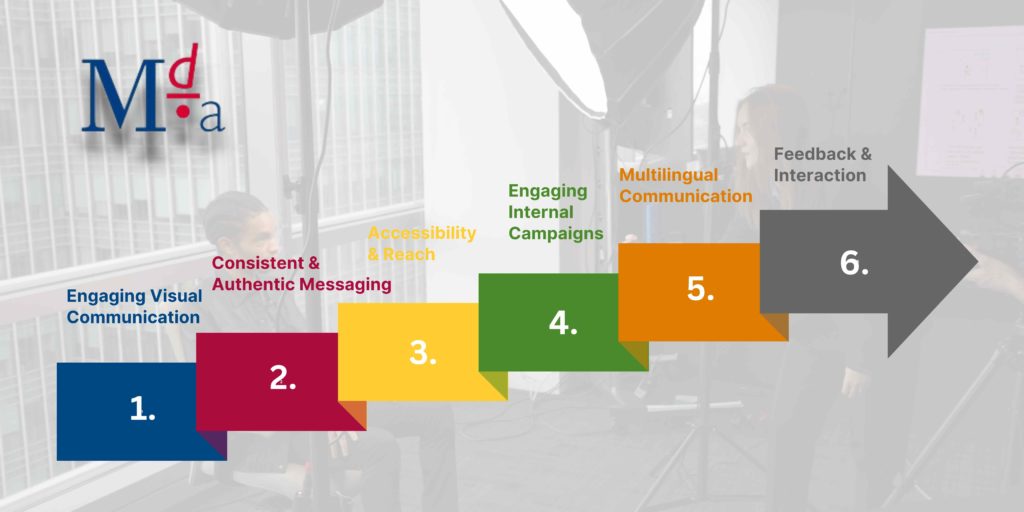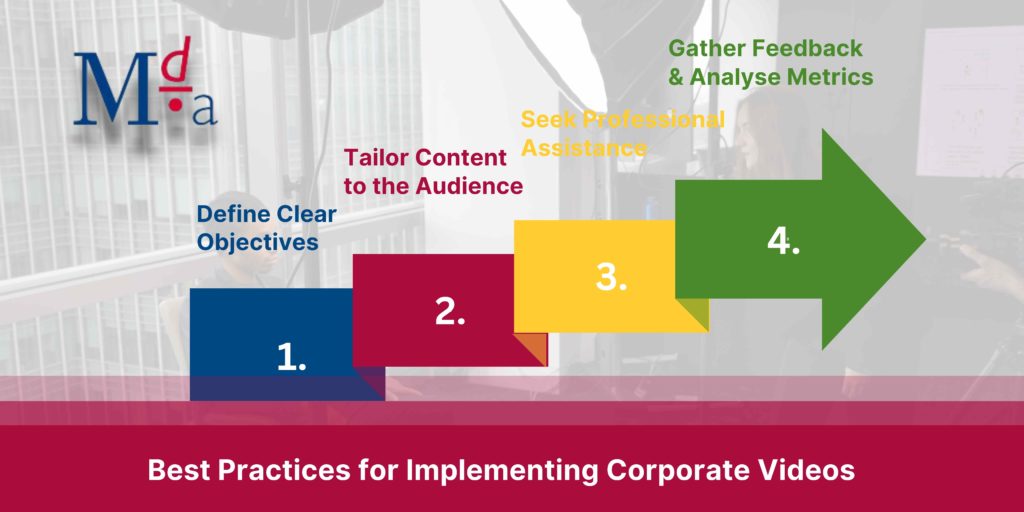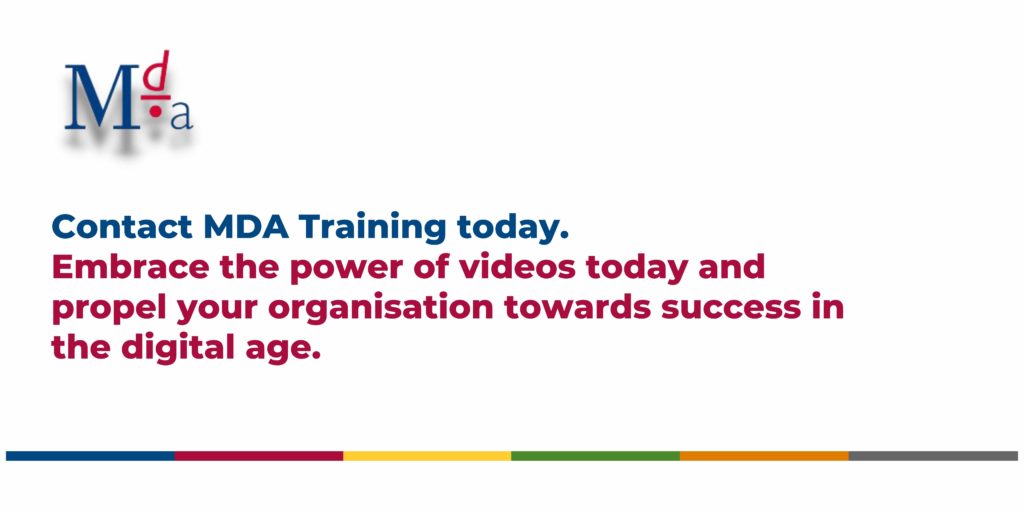Corporate video production as a solution for employee training and communication is nothing new. Oz Hussein, Director at MDA Training says – “I for one, remember the days of bringing in a full film crew, going through tape after tape of footage, watching round after round of rough cuts and then waiting for hours for final render, only to see something in the final film that requires further editing and another lengthy render!”
It goes without saying that technology has brought many innovations to corporate video production, from filming, through post-production and editing, to media output. Some would argue that smartphones have made film-making accessible to all and that the quality is good enough, including employee training and communication.
Oz acknowledges this perspective, stating- “I wouldn’t disagree. We even have a filmmaking activity where participants make films for team building. But it has to be said, utilising the services of a professional film production team can add so much to the mix at every stage. From storyboarding and brainstorming approaches that may otherwise not be considered, through to utilising the latest picture-perfect cameras, to professionally editing the footage and applying visual effects that will land the learning on your chosen media format or social channel.”
Why Corporate Videos?
1. Enhancing Employee Training
Employee training plays a vital role in ensuring that individuals are equipped with the necessary skills and knowledge to perform their job effectively. Traditional training methods, such as seminars and presentations, can be monotonous and fail to capture the attention of employees. This is where corporate videos come into play.
Corporate videos offer a dynamic and engaging way to deliver training content. By incorporating visuals, animations, and storytelling techniques, videos can make complex concepts more understandable and memorable. Employees are more likely to retain information presented in a visually appealing and interactive manner, leading to better learning outcomes.
Furthermore, corporate videos can be accessed anytime and anywhere, making them convenient for employees to revisit whenever they need a refresher. This flexibility allows individuals to learn at their own pace, boosting overall productivity and efficiency.
A) The Power of Visual Learning
Visual learning is a proven method for increasing knowledge retention and engagement. When employees are presented with information through visual mediums, such as videos, they are more likely to absorb and understand the content. Visuals have the ability to simplify complex concepts, break down information into digestible parts, and stimulate cognitive processes.
Corporate videos can incorporate a variety of visual elements to enhance the learning experience. These may include graphics, charts, animations, and real-life demonstrations. By presenting information in a visually appealing manner, videos capture the attention of employees and create a more immersive and memorable training environment.
B) Interactive and Engaging Content
Employee training should go beyond the passive consumption of information. Interactive and engaging content encourages active participation, which leads to better learning outcomes. Corporate videos can include interactive elements such as quizzes, polls, or scenarios that require employees to make decisions. This not only tests their understanding but also promotes critical thinking and problem-solving skills.
In addition, videos can incorporate gamification elements, turning the training process into a fun and rewarding experience. By introducing challenges, achievements, and leaderboards, employees are motivated to actively engage with the content and strive for improvement.
C) Consistency and Scalability
Corporate video production offers the advantage of consistent and scalable training delivery. Once a video is created, it can be easily shared and accessed by employees across various locations and time zones. This ensures that everyone receives the same training content, eliminating inconsistencies that may arise from different trainers or presentations.
Moreover, as companies grow and new employees join, videos can be used as an onboarding tool. New hires can watch training videos to quickly familiarise themselves with company policies, procedures, and values. This scalable approach saves time and resources while maintaining the integrity of the training material.
D) Flexibility and Accessibility
One of the key benefits of corporate videos is their flexibility and accessibility. Unlike live training sessions that require participants to be present at a specific time and place, videos can be accessed at any time and from anywhere. This flexibility allows employees to learn at their own pace and convenience, catering to different learning styles and schedules.
Furthermore, videos can be divided into shorter modules or chapters, making it easier for employees to navigate and revisit specific topics as needed. This on-demand accessibility empowers employees to take control of their learning journey and reinforces knowledge retention.
E) Real-Life Scenarios and Case Studies
To make training more practical and applicable to real-life situations, corporate videos can incorporate scenarios and case studies. By presenting employees with relatable examples, they can better understand how to apply their training in their day-to-day work.
Including testimonials from employees who have successfully applied their training can also be beneficial. Hearing firsthand experiences creates a sense of authenticity and encourages others to embrace the training with confidence.
F) Ongoing Training and Updates
Training is an ongoing process, and corporate videos provide a valuable resource for continuous learning and updates. As technologies, processes, or industry standards evolve, videos can be updated or new videos can be created to ensure employees stay up to date.
Additionally, videos can serve as a reference library, allowing employees to refresh their knowledge or revisit specific topics whenever needed. This self-paced approach to training promotes a culture of lifelong learning within the organisation.
2. Facilitating Effective Communication
Communication is the backbone of any successful organisation. It enables seamless collaboration, alignment of goals, and a shared understanding among employees. However, conveying information across various departments or branches can be challenging, especially in large corporations.
Corporate videos provide a powerful medium to streamline communication channels within an organisation. Through well-produced videos, key messages can be communicated consistently and efficiently. Whether it’s sharing updates from senior management, introducing new policies, or celebrating achievements, videos capture attention and deliver messages effectively.
Videos also have a personal touch, allowing employees to connect with leaders and feel more involved in the company’s vision. This fosters a sense of belonging and promotes a positive work culture.
A) Engaging Visual Communication
In today’s fast-paced business environment, effective communication is essential for fostering collaboration, aligning goals, and building a cohesive work culture. Traditional forms of communication, such as memos or emails, may lack the impact needed to capture employees’ attention and convey messages effectively. This is where corporate videos excel.
Corporate videos provide a dynamic and engaging medium for communication. By incorporating visuals, animations, and storytelling techniques, videos can deliver messages in a compelling and memorable way. Visual communication has been shown to be more effective than text-based communication alone, as it stimulates both the visual and auditory senses, leading to increased message retention and understanding.
B) Consistent and Authentic Messaging
Consistency in messaging is crucial for aligning employees with organisational goals and values. With corporate video production, organisations can ensure that messages are delivered consistently across different teams, departments, or geographical locations. This consistency helps create a unified company culture and fosters a shared understanding of the organisation’s vision and objectives.
Moreover, videos provide an opportunity to add a personal touch to communication. Seeing and hearing leaders or subject matter experts deliver messages creates a sense of authenticity and connection. Employees are more likely to engage with and trust messages delivered through video, resulting in stronger communication outcomes.
C) Accessibility and Reach
In large organisations or those with remote teams, reaching every employee with important updates can be challenging. Corporate videos offer a solution by providing accessible and scalable communication channels. Once a video is created, it can be shared easily across various platforms, such as intranets, email, or internal communication tools.
Employees can access videos at their convenience, regardless of their location or time zone. This ensures that everyone receives the same information simultaneously, reducing miscommunication and ensuring that all employees are on the same page. Additionally, videos can be archived and accessed later for reference, allowing employees to revisit important messages when needed.
D) Engaging Internal Campaigns and Initiatives
Internal campaigns and initiatives, such as introducing new policies, promoting employee well-being, or celebrating achievements, can be effectively communicated through corporate videos. Videos provide a creative platform to capture employees’ attention, generate excitement, and inspire action.
By leveraging storytelling techniques, visuals, and music, videos can convey the desired emotions and engage employees on an emotional level. This emotional connection increases the likelihood of employees embracing the initiatives and actively participating in company-wide campaigns.
E) Multilingual Communication
In organisations with diverse workforce and language barriers, corporate videos can bridge the communication gap. By incorporating subtitles or providing multiple language versions, videos ensure that messages are understood by employees who may have different native languages or levels of English proficiency.
Multilingual videos promote inclusivity and ensure that all employees, regardless of their language background, receive important information in a format they can comprehend. This enhances overall communication effectiveness and fosters a sense of belonging among employees from various cultural backgrounds.
F) Feedback and Interaction
Effective communication is a two-way process. Corporate videos can incorporate interactive elements, such as surveys, polls, or comment sections, to encourage employees to provide feedback, ask questions, or share their insights. This creates a space for dialogue and promotes a culture of open communication within the organisation.
Videos can also be used to facilitate training sessions, team discussions, or town hall meetings. By sharing videos ahead of time, employees can come prepared with their thoughts and engage in more meaningful and productive discussions. This interactive approach strengthens communication channels and ensures that employees feel heard and valued.
Key Elements of Effective Corporate Videos
To ensure the success of corporate videos for employee training and communication, several key elements should be considered:
1. High Production Quality
Investing in high production quality is essential to capture and maintain the attention of employees. Clear visuals, professional audio, and polished editing create a polished and engaging video experience. Poorly produced videos may result in disengagement and hinder the effectiveness of the message.
2. Script and Storytelling
Crafting a compelling script and incorporating storytelling techniques can significantly enhance the impact of corporate videos. A well-structured narrative, supported by relatable examples or case studies, can captivate the audience and facilitate better information retention.
3. Visual Representation
Visual elements, such as graphics, animations, and demonstrations, can simplify complex concepts and increase comprehension. They add visual interest to the video and help employees visualise abstract ideas more effectively.
4. Length and Format
Considering attention spans and the busy schedules of employees, it is crucial to keep videos concise and focused. Breaking down information into bite-sized videos or incorporating chapters and timestamps allows employees to access specific sections as needed.
5. Accessibility and Interactivity
Ensuring videos are easily accessible across different devices and platforms promotes engagement and inclusivity. Additionally, incorporating interactive elements, such as quizzes or knowledge checks, encourages active participation and reinforces learning.
Best Practices for Implementing Corporate Videos
To maximise the impact of corporate videos, consider the following best practices:
1. Define Clear Objectives
Before embarking on video production, clearly define the objectives and goals you aim to achieve. Whether it’s improving safety procedures, enhancing product knowledge, or fostering a collaborative environment, having a clear purpose will guide the content creation process.
2. Tailor Content to the Audience
Understanding the needs and preferences of your target audience is key to creating relevant and engaging videos. Consider the demographics, roles, and learning styles of your employees when designing the content. Personalisation goes a long way in capturing attention and driving message retention.
3. Seek Professional Assistance
While it’s possible to create videos in-house, engaging professional videographers or video production agencies can elevate the quality and effectiveness of your corporate videos. They possess the expertise, equipment, and creative vision to bring your ideas to life and deliver impactful results.
4. Gather Feedback and Analyse Metrics
After implementing corporate videos, gather feedback from employees to assess their effectiveness and identify areas for improvement. To gauge the effectiveness of corporate training videos, it is essential to establish measurable goals and collect feedback from employees. Surveys, quizzes, or knowledge checks embedded within the videos can provide valuable insights into employees’ comprehension and engagement levels.
Analysing metrics such as completion rates, view counts, or feedback forms can help identify areas of improvement and refine future training content. By continuously evaluating the effectiveness of corporate videos, organisations can make data-driven decisions and optimise their training programs for better results.
What’s Next?
Corporate Video Production for Employee Training and Communication has stood the test of time and certainly is here to stay. At MDA Training, we specialise in helping organisations harness the power of corporate video production to enhance employee training and communication. Through our expertise, we can assist you in creating high-quality videos that will elevate the effectiveness of your training programs and streamline your communication channels. By leveraging the benefits of videos, we aim to foster a more engaged and informed workforce within your organisation.
We understand the importance of investing in high-quality production, compelling storytelling, and tailoring content to meet the needs of your audience. Embrace the power of videos today and propel your organisation towards success in the digital age. Get in touch with MDA Training now to discover how we can assist you.















